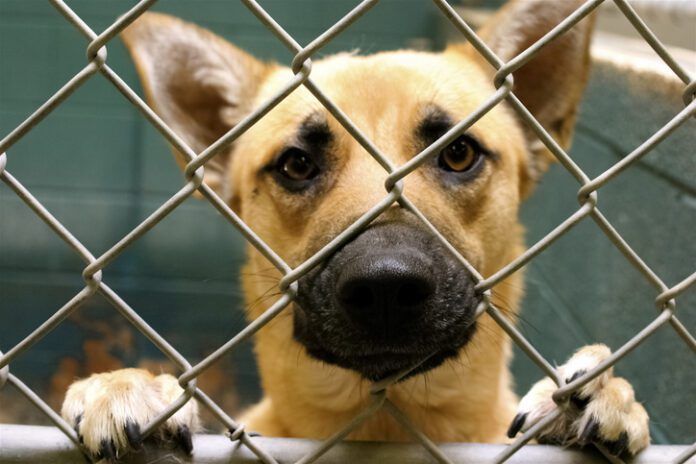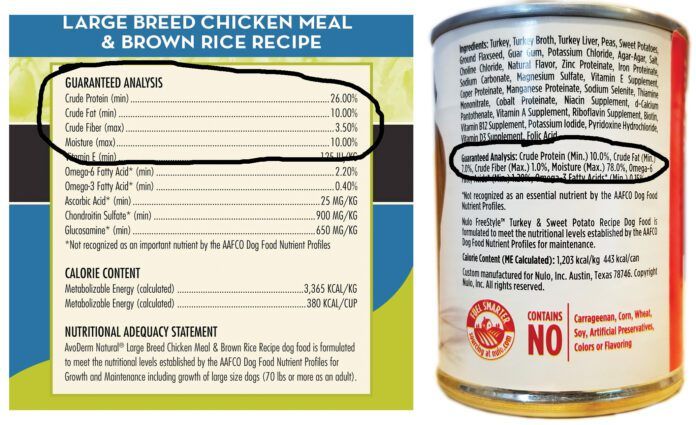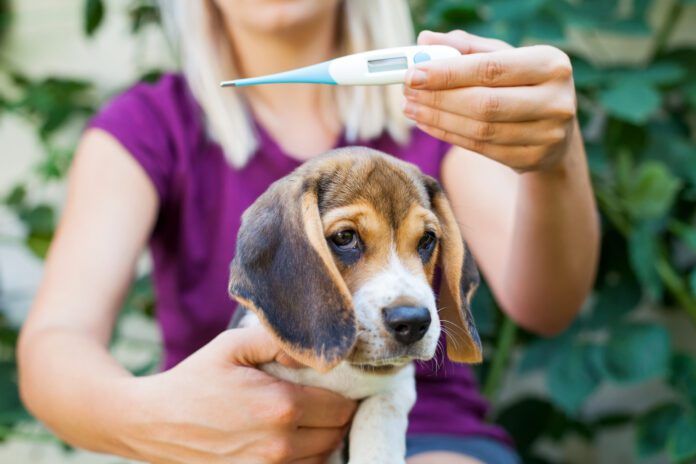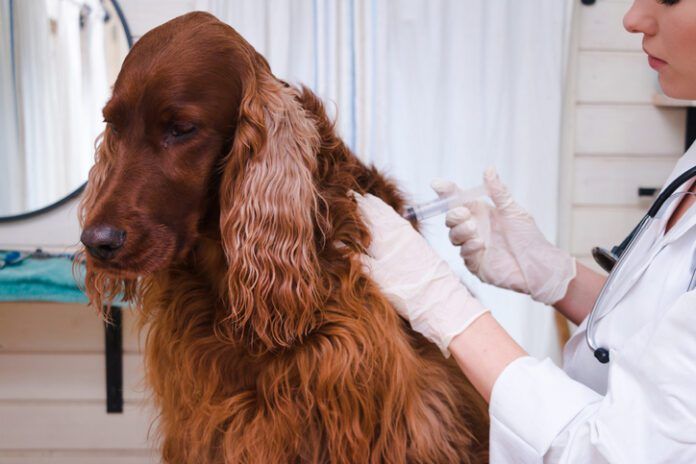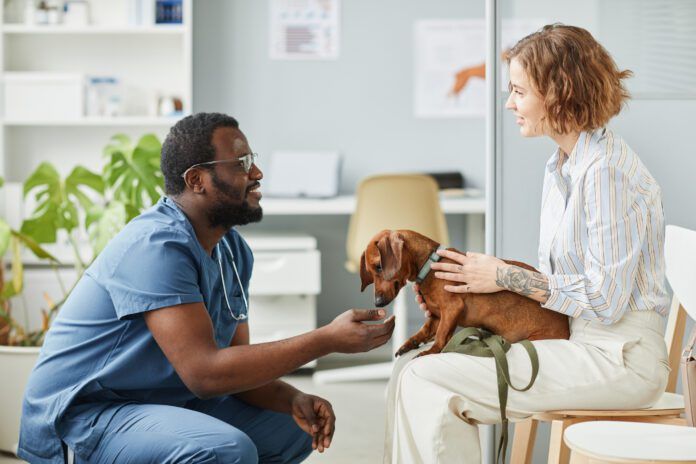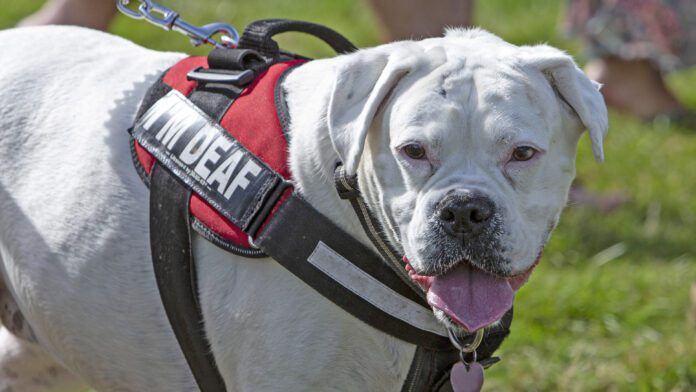Federal and state laws require pet food makers to put information about the protein and fat content of their products on pet food labels. Unfortunately, few people understand this critical information, making their purchasing decisions based on some of the most insignificant words or pictures on the label. Here’s what you need to know to understand what’s in the bag or can – and to compare one food to another.
Minimums, maximums, and actual amounts
Every pet food label is required to display a “guaranteed analysis” that includes the minimum percentages of crude protein and crude fat and the maximum percentages of crude fiber and moisture that are present in that food “as fed” – as they are in the food’s present form.
Protein and fat are the most important (and costly) nutrients in a dog’s food, so these are reported as guaranteed minimums; this ensures that dogs receive the minimum amounts necessary for health.
Moisture (water) and fiber, being empty of nutrients, are listed by their maximum amounts; this ensures that consumers know the maximum amount of the food’s contents that is without nutrients.
All these amounts are subject to surveillance, testing, and enforcement by feed control officials in every state where the product is sold.
It’s important to understand that the minimum and maximum amounts listed in the guaranteed analyses are just that: minimums and maximums. The actual amount of those nutrients may be significantly different. For example, the minimum fat guarantee on a label may be 8%, but the product might contain 15% fat or more. Similarly, a product with a maximum guarantee of 5% fiber may actually contain only 1%.
Some product manufacturers report more accurate numbers for their products’ nutrients in what’s usually called a “typical nutrient analysis.” These analyses may reflect nutrient levels that have been calculated by a computer analysis of the product’s ingredients and formula, or levels that have been determined by laboratory tests of the product. The most transparent, consumer-friendly pet food makers publish typical nutrient analyses for all of their products on their websites. Other companies make these available by request – and some companies don’t make them available at all!
If it’s critical to your dog’s health that you feed a very specific amount of protein (for a dog with diminished kidney function, for example), fat (say, for a dog who is prone to pancreatitis), or fiber (for a dog prone to constipation or diarrhea), we’d recommend considering only those foods with a readily available typical nutrient analysis.
Further, for the most precise comparison to other products and products of different types (canned, dry, etc.), it’s ideal if these analyses list their nutrient contents in two ways: “as-fed” (meaning, the food as it is presented in its package) and as “dry matter” (the nutrient levels in the food if all of the water were removed).
Why the “dry matter” values matter
Have you ever wondered about the disparity between the amounts of protein or fat listed on the canned (or fresh frozen) food you give your dog, and those on the bag of dry or freeze-dried food he eats? A good-quality dry food may have a minimum of 28% protein listed, while a comparable canned food may be labeled as having just 7% protein. How can a dog live on the (seemingly) paltry amounts of nutrients in canned and fresh foods?
Answer: A dog can subsist on those amounts because they are anything but paltry! In fact, high quality canned and fresh/frozen foods usually contain more fat and protein than high-quality dry foods – if you go by the dry matter values.
In order to directly compare the protein or fat content of one type of food (i.e., canned, dry, raw frozen, or freeze-dried) to another type, you need to consider them on a level playing field. Each of these types of food contains highly disparate amounts of moisture, which affects the “as fed” percentages. The nutrient levels in high-moisture foods are, in effect, diluted.
To compare the nutrient levels in products with disparate amounts of moisture, you have to remove all the moisture from each product. This is easy to do mathematically.
The first step in comparing any two products of different types is to convert the as-fed amounts on the label to dry matter (DM) values. Do this by subtracting the amount of moisture on the label from 100. The result is the food’s dry matter or DM factor.
100 − moisture % = dry matter or DM factor
Then you can divide any listed nutrient percentage by the DM factor to determine its dry matter percentage. For example:
Protein % ÷ DM factor = DM protein
Multiply by 100 to show it as a percentage
Example Label #1 (dry dog food)
Protein (min) 28%
Moisture (max) 9%
100 − Moisture % = DM factor
100 – 9 = 91
The DM factor for this food is 91
To determine the percentage of dry matter protein in this food, take the listed protein percentage (in this case, 28) and divide it by the food’s DM factor (91):
28 ÷ 91 = 0.31
This food is 31% protein by DM
Let’s look at a canned food. The math looks a little different, because the moisture content is so high in canned foods, which makes the dry matter factor number small. The high amount of moisture also makes the as-fed nutrient amounts small (they are literally diluted!). But you use the same formula – and you may be surprised by the result. Check it out:
Example Label #2 (canned dog food)
Protein (min) 7%
Moisture (max) 78%
100 – 78 = 22
The DM factor for this food is 22
To determine the percentage of dry matter protein in this food, take the listed protein percentage (in this case, 7) and divide it by the food’s DM factor (22).
7 ÷ 22 = 0.31
This food is 31% protein by DM
Did that surprise you? Notice that both the dry food in Example Label #1 and the canned food in Example Label #2 contain the same amount of dry matter protein (31%), even though the “as fed” numbers on their labels look very different. If you were trying to find a dry and a canned food that contained a moderate and consistent amount of protein for your dog, you’d do well to run these calculations, to make sure that both types of food offer an appropriate (and similar, if not matching) amount of protein.
What about carbohydrates?
Carbohydrates are not usually listed on a guaranteed analysis, but, if you’ve gotten this far, they are easy to compute. But in order to do so, we have to add one more “nutrient” to the calculation.
The “ash” content of dog food is rarely discussed, even though some pet food manufacturers list the maximum amount of ash in their products on the guaranteed analysis. This is not required, but it’s helpful for dog owners who know what ash is.
Ash is essentially what would be left over if you were to put the food in an oven and burn away everything that could burn; what’s left are all the minerals in the food. Calcium and phosphorus constitute the vast majority of these minerals (interestingly, you could use the ash total as a rough estimate of how much calcium and phosphorus are in the diet), but even the iron, copper, zinc, magnesium, selenium, and the rest of the trace minerals in the food contribute to the total amount of ash.
Though all dog foods need to contain some ash – as they all need to contain the minerals required by dogs – low-quality foods often contain fairly high levels of ash, as much as 10% or more. High levels of ash can impede a dog’s ability to absorb other nutrients – which is why you will almost never see the amount of ash reported by the makers of cheap, low-quality foods, but you may see low amounts of ash voluntarily included in the guaranteed analysis by makers of high-quality foods.
Back to carbohydrates: In order to calculate what percentage of a food is carbohydrates, add the as-fed (label) percentages for protein, fat, fiber, moisture, and ash, subtract their total from 100, and divide the result by the DM factor.
If you can’t find the ash content for a particular food, you can use an estimate of between 5% and 9% as the ash percentage of a canned or dry food. You can use an estimate of between 1% and 4% for the ash percentage of most fresh or frozen raw foods.
Let’s look at another example:
Example Label #3
Protein (min) 28%
Fat (min) 18%
Fiber (max) 3%
Moisture (max) 9%
Ash (max) 9%
To find the carbs in this food, add the label percentages for protein, fat, fiber, moisture, and ash:
28 + 18 + 3 + 9 + 9 = 67
Subtract this total from 100:
100 – 67 = 33
Divide this result by the dry matter factor (for this food, the DM factor is 91):
33 ÷ 91 = 0.36
This food is 36% carbohydrates by DM
Don’t be intimidated!
These calculations are not difficult, just a bit tedious. If you follow along through a few more, you’ll begin to see how easy it is – and how much more you can learn about your dog’s food by doing some math.
Example Label #4 (raw frozen food)
Crude protein 12% min
Crude fat 11% min
Crude fiber 1% max
Moisture 72% max
Ash 3% max
Find the dry matter factor by subtracting the moisture % from 100:
100 – 72% moisture = 28 DM factor
Find the dry matter protein percentage by dividing the label’s protein (12%) by the DM factor (28):
12 ÷ 28 = 0.43
This food is 43% protein by DM
To calculate its carbohydrate percentage, add protein + fat + fiber + moisture + ash:
12 + 11 + 1 + 72 + 3 = 99
Subtract that result from 100:
100 – 99 = 1
Divide that answer by the DM factor (28):
1 ÷ 28 = 0.035
This food is 3.5% carbohydrates by DM
This is a very low-carb food, typical of many raw-food diets. (Remember, dogs don’t have a nutritional requirement for carbohydrates; they can live on fat and protein alone. Dietary fiber offers some functional benefits – read “Dietary Fiber for Dogs” – but many dogs thrive on low- or no-carb diets.)
Ok, just one more. For fun, let’s look at a food that’s on the other end of the carb-content scale. This one is a brand every dog owner knows:
Example Label #5
Crude protein 21% min
Crude fat 10% min
Crude fiber 5% max
Moisture 12% max
Ash (not listed, so estimate) 6%
Find the dry matter factor by subtracting the moisture % from 100:
100 – 12% = 88 DM factor
Find the dry matter protein percentage by dividing the label’s protein (21%) by the DM factor (88):
21 ÷ 88 = 0.24
This food is 24% protein by DM
To calculate its carbohydrates, add the label’s protein + fat + fiber + moisture + ash:
21 + 10 + 5 + 12 + 6 = 54
Subtract that result from 100:
100 – 54 = 46
Divide that answer by the DM factor (88):
46 ÷ 88 = 0.52
This food is 52% carbohydrates by DM
The more you know . . .
When I first came across descriptions of how to calculate dry matter percentages, my brain would freeze. But with practice, it has become easy and even fun – especially when I can exclaim over the carb counts for most grocery-store kibbles. Carbohydrate-wise, we might as well just feed our dogs cinnamon buns! I hope you find this important subject as interesting as I do.
Related Articles
SUBSCRIBER ONLY: WDJ’s 2024 Approved Dry Dog Foods: Search Over 1,000 Varieties
What’s the Best Dry Dog Food? 2024’s Top Picks in 8 Categories
How to Find Healthy Dog Food: WDJ’s Dry Dog Food Selection Criteria


